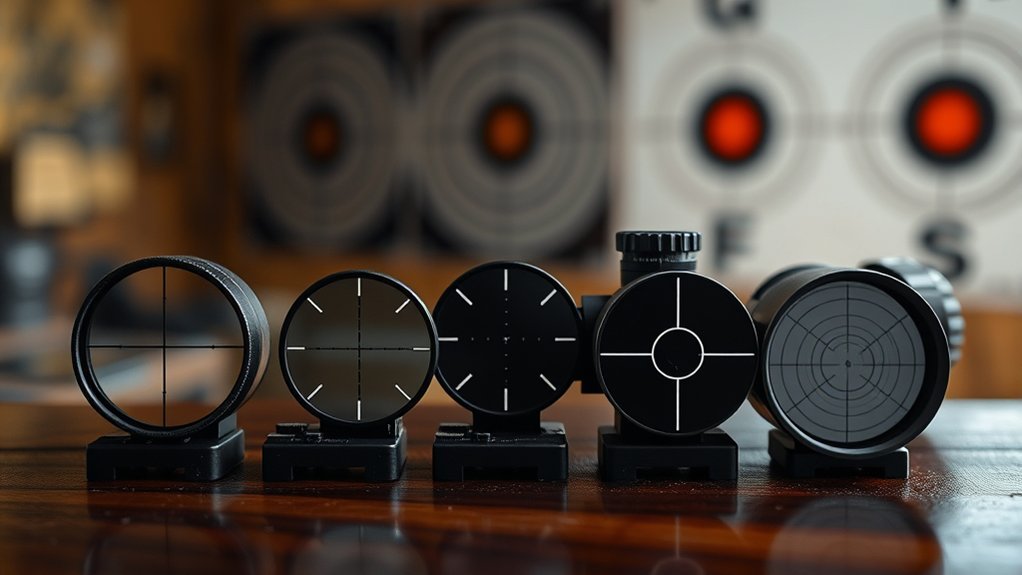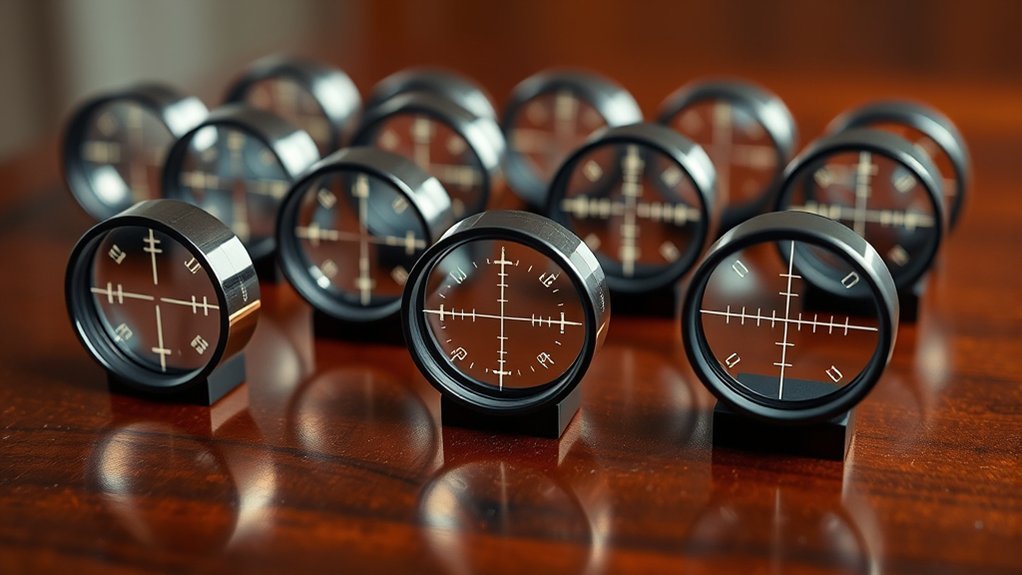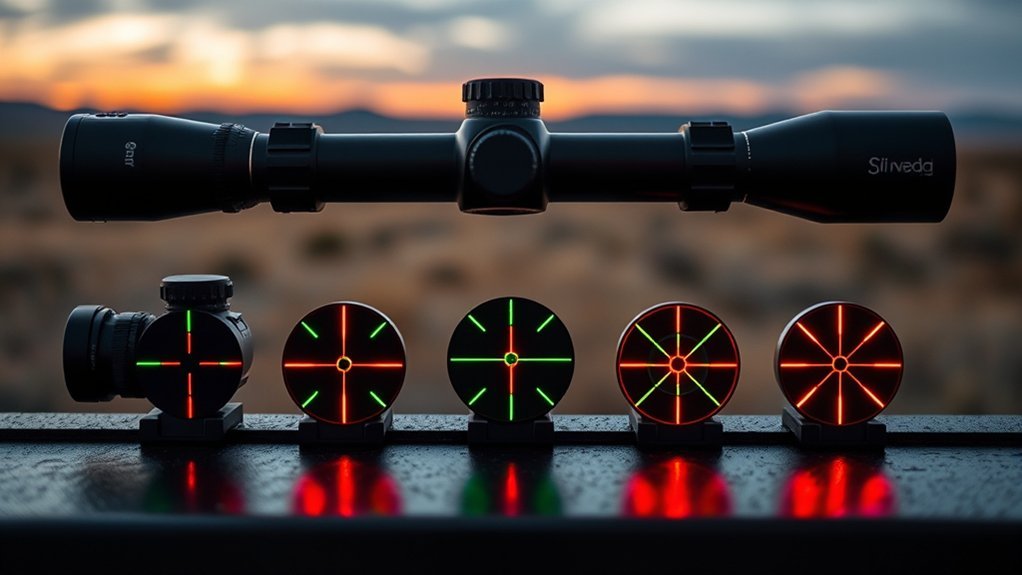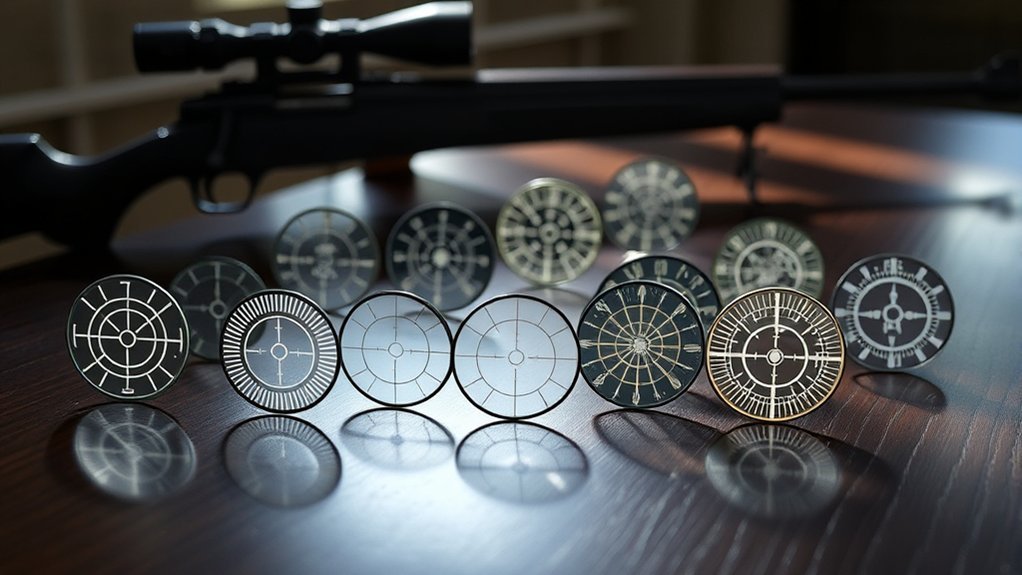When it comes to choosing the right reticle type, understanding the various options available is essential for optimizing your shooting performance. Each reticle serves a distinct purpose, from traditional crosshairs to advanced Mil-dot designs. Your choice can greatly impact accuracy in different environments and distances. So, how do you determine which reticle best suits your shooting needs? Let’s explore the key factors that will guide your decision.
Understanding Reticle Types

When it comes to selecting the right reticle for your scope, understanding the different types can make all the difference in your shooting experience. Reticles come in various designs, each serving unique purposes. Mil-dot reticles, for instance, allow you to estimate distance and lead moving targets accurately. BDC (Bullet Drop Compensation) reticles feature markings to account for bullet drop at various distances, enhancing long-range accuracy. Additionally, illuminated reticles provide visibility in low-light conditions, enabling precise aiming when needed most. Finally, range-finding reticles combine distance estimation with target size calculations, perfect for tactical applications. By knowing these options, you can choose a reticle that best fits your shooting style and enhances your effectiveness in the field.
Traditional Crosshair Reticles

Traditional crosshair reticles are a staple in the world of optics, valued for their simplicity and effectiveness. These reticles feature two intersecting lines that form a cross, allowing you to easily align your target. Their straightforward design minimizes distractions, enhancing focus on the subject. Crosshair reticles come in various styles, including thin lines for precision shooting and thicker lines for quicker target acquisition in dynamic environments. They’re commonly found in hunting, tactical, and sporting scopes. When using a traditional crosshair, you’ll benefit from a clear sight picture, which aids in accurate shot placement. It’s essential to choose a crosshair that suits your shooting needs and preferences, ensuring peak performance in the field.
Illuminated Reticles

While traditional crosshair reticles excel in many scenarios, illuminated reticles offer distinct advantages, especially in low-light conditions. These reticles utilize LED technology to light up the crosshairs, enhancing visibility against dark backgrounds. You’ll find illuminated reticles available in various colors, allowing you to customize your setup based on personal preference or environmental factors. The brightness settings often range from low to high, enabling you to adjust for ideal clarity without causing glare. This adaptability proves essential during twilight hunts or in dimly lit environments. Additionally, illuminated reticles maintain their effectiveness during rapid target acquisition, helping you stay focused and accurate. Overall, if you frequently operate in low light, an illuminated reticle could greatly improve your shooting experience.
BDC (Bullet Drop Compensation) Reticles
BDC (Bullet Drop Compensation) reticles are designed to enhance accuracy over varying distances by incorporating markings that account for bullet drop. These reticles allow you to engage targets effectively without the need for constant range adjustments. Here are some key features to evaluate:
BDC reticles enhance shooting accuracy over varying distances, allowing for effective target engagement without constant scope adjustments.
- Distance Markings: They provide specific aim points for various distances, typically ranging from 100 to 600 yards.
- Easy Calculation: You can quickly determine holdover points based on your caliber and load.
- Simplified Target Engagement: You won’t have to adjust your scope frequently, streamlining the shooting process.
- Versatile Applications: BDC reticles are useful for hunting, target shooting, and tactical scenarios.
Mil-Dot Reticles
Mil-Dot reticles offer a unique approach to range estimation and bullet drop compensation, building on the principles of accuracy established by BDC reticles. With Mil-Dots spaced at one-mil intervals, you can quickly estimate distance to targets, especially at varying ranges. This system is particularly useful for long-range shooting, as it enhances your ability to make precise adjustments.
| Target Size (inches) | Distance (yards) | Mil-Dots Required |
|---|---|---|
| 6 | 600 | 6 |
| 10 | 1000 | 10 |
| 18 | 1200 | 18 |
MOA (Minute of Angle) Reticles
When using an MOA reticle, you’ll benefit from a clear understanding of how MOA measurements translate to bullet trajectory and adjustments. MOA, which equates to approximately 1.047 inches at 100 yards, allows you to make precise corrections for distance and windage. This precision makes MOA reticles popular among shooters who prioritize accuracy in their long-range engagements.
Understanding MOA Measurements
Although many shooters might be familiar with various reticle types, understanding Minute of Angle (MOA) measurements is essential for accurate shooting and effective range estimation. MOA is a unit of angular measurement used in shooting, where 1 MOA equals approximately 1.047 inches at 100 yards. Here are key aspects you should know:
- Distance Calculation: MOA helps you adjust for bullet drop over distances.
- Windage Correction: It provides a basis for compensating for wind drift.
- Target Size: MOA allows you to estimate target sizes at varying distances.
- Scope Adjustment: Knowing MOA aids in making precise adjustments on your scope.
Benefits of MOA Reticles
Understanding MOA measurements lays the groundwork for recognizing the advantages of MOA reticles in your shooting setup. One significant benefit is the simplicity of adjustments; 1 MOA equates to approximately 1 inch at 100 yards, making it easier to calculate bullet drop and windage. This consistency allows for quick and accurate shot placement, especially at varying distances. MOA reticles often feature hashmarks that facilitate precise aiming points, enhancing your overall shooting experience. Additionally, many shooters find MOA reticles intuitive for both hunting and competition, supporting fast target acquisition. With the ability to make fine adjustments, you can adapt to changing conditions seamlessly, improving your effectiveness and confidence when taking shots. Overall, MOA reticles enhance precision and simplify your shooting process.
Selecting the Right Reticle for Your Needs
When selecting a reticle, consider its purpose based on your shooting needs, whether for hunting, target practice, or tactical applications. Your preferences in reticle style, such as illuminated vs. non-illuminated or simple vs. complex designs, will also play a vital role in your choice. Evaluating these factors will help you find a reticle that enhances your shooting experience and accuracy.
Purpose of Reticle Type
Choosing the right reticle type is essential for maximizing your accuracy and effectiveness in various shooting scenarios. The purpose of a reticle goes beyond mere aesthetics; it directly influences your shooting experience. Here are four key factors to take into account:
- Range Estimation: Different reticle types help you gauge distances more effectively.
- Target Acquisition: Some reticles allow for quicker target acquisition, vital in fast-paced environments.
- Environmental Conditions: Certain designs enhance visibility in low light or bright conditions.
- Shooting Discipline: The right reticle supports your specific shooting discipline, whether it’s tactical, hunting, or competitive.
Reticle Style Preferences
Selecting the right reticle style greatly impacts your shooting performance across various scenarios. You’ll find that different styles cater to specific needs, from precision shooting to quick target acquisition. Understanding these preferences can enhance your accuracy and effectiveness.
| Reticle Style | Ideal Use Case | Advantages |
|---|---|---|
| Duplex | General hunting | Fast target acquisition |
| Mil-Dot | Tactical shooting | Range estimation |
| BDC (Bullet Drop Compensator) | Long-range shooting | Compensates for bullet drop |
When choosing, consider your shooting environment, distance, and personal comfort. Each reticle style offers unique benefits, so align your choice with your shooting objectives for peak performance.
Conclusion
Now that you’ve explored various reticle types, the choice is in your hands. Will you opt for the precision of a Mil-Dot reticle, the adaptability of a BDC, or the simplicity of a traditional crosshair? Each option holds unique advantages, but the right selection could be the difference between success and a missed shot. Consider your shooting goals carefully—your next target awaits, and the perfect reticle could be the key to revealing your full potential.

